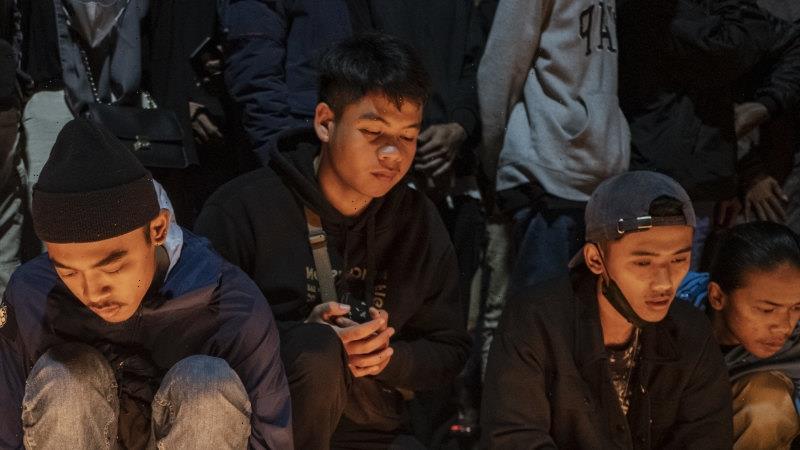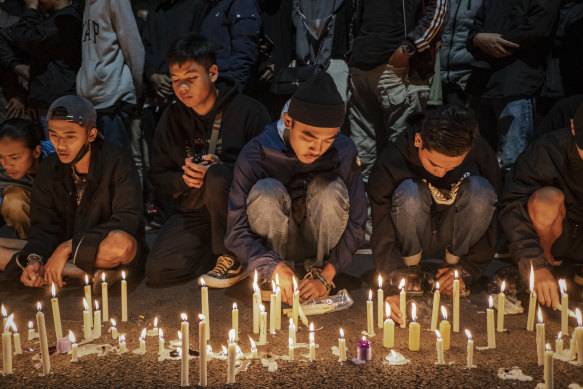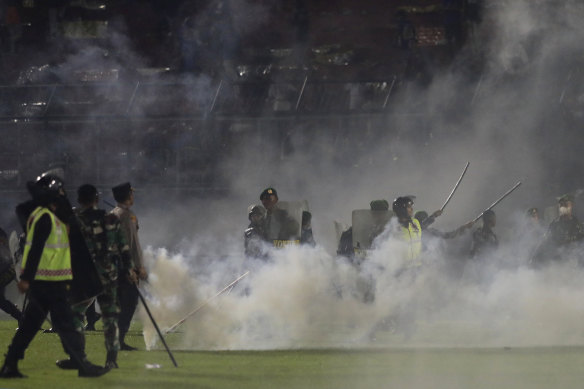Joshua had gone to Kanjuruhan Stadium in Malang, Indonesia, with his wife and 13 friends, all Arema football fans.
For many of them, their team’s loss was devastating. It was only the club’s second defeat since 2019.
Arema football club supporters light candles during as they pray for the victims on October 02, 2022 in Malang, Indonesia.Credit:Getty Images
After the match, the players and the club’s management stood on the field, apologising for the defeat. Then, two or three angry fans came down from the stands and were seen shouting at the players, said Joshua, as he is known in Indonesia (Javanese often do not use family names). Police officers entered to turn the fans back, prompting more people to come onto the field.
Some scuffling between police and fans prompted the first burst of tear gas to be fired at about 10.30pm local time, according to Joshua. Several more sporadic rounds were fired into the field for the next 30 minutes.
People were trying to leave then, but stadium officials had kept many of the exits closed because angry fans were clashing with police outside.
Then at 11pm, security forces suddenly started firing tear gas at a steady clip into the spectator stands, Joshua said. That prompted hundreds of people to rush to the exits. The firing of the tear gas did not let up for an hour, according to Joshua.
Police officers and soldiers stand amid tear gas smoke after clashes between fans during a soccer match at Kanjuruhan Stadium in Malang, East Java, Indonesia. Credit:AP
Joshua and his friends, seated in the VIP section, were not directly hit. But the clouds of tear gas that wafted over made it hard for many of them to breathe, and the nonstop firing of tear gas caused panic.
Each section had only a narrow lane for people to exit. To get out, he said, some people had to scale fences that were about 5 meters high, clambering over other panicked spectators.
“They were actually trying to get out of the stadium to avoid the chaos, but they couldn’t because there was also fighting between the fans and the police outside the stadium,” Joshua said.
Many people fainted, he said, adding that police stood by and did nothing. He saw a boy of perhaps 13 or 14 crying and screaming from the pandemonium.
Most of those who died were spectators in the stands, he said, and not those on the field.
“If there wasn’t any tear gas shot into the stands, there would have not been any casualties,” Joshua said. “They were panicked and their only choice was to get out from the exits or find refuge in the field. That is why there were many people who went down to the field. They were actually trying to save themselves.”
When Joshua finally managed to escape, it was just after midnight. He saw people being carried out of the stadium, glass shards everywhere and cars being burned.
He said he could not sleep last night because he could not shake the images from his mind.
“When I close my eyes, I can still hear the voices screaming for help,” he said. “It’s echoing in my ears. I don’t want to become a football supporter anymore. I don’t want to watch any Indonesian football match again. I hope football in Indonesia would be abolished.”
This article originally appeared in The New York Times.
Most Viewed in World
From our partners
Source: Read Full Article


